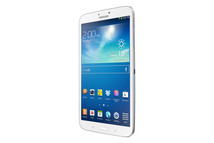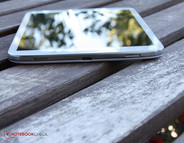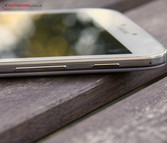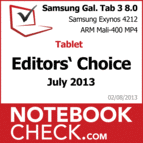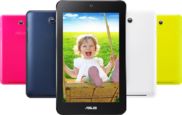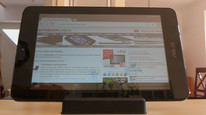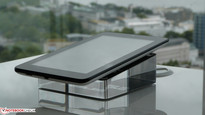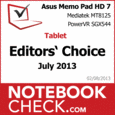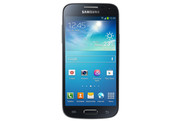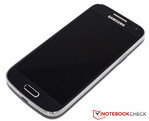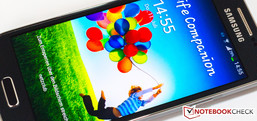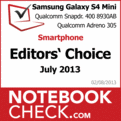Notebookcheck's Best of July 2013 – Smartphone and Tablet Edition
For the original German article, see here.
In June, BlackBerry countered Samsung once again with their Q10 and its impressive physical keyboard, regaining the throne. May, on the other hand, belonged to Samsung, and now they can claim July too. But each has his turn.
The ratio of smartphones to tablets has thus far been quite even. But in July, we were hit with a wave of smartphones. Our test lab received a whopping 11 devices from all kinds of classes. However, the tide ebbed in the tablet sector: We only had four models to review, a record low. Even so, we did get a chance to look at some exciting devices.
The Acer Iconia-W3-810-27602G03nsw was another Windows 8 tablet with an Intel Atom CPU. The 8.1-inch compact device proved to be remarkable, making life hard for the Android competition. This time around, the Android competition consisted of Samsung and Asus devices. The South Korean manufacturer is already releasing the third generation in their Galaxy Tab line, and the 7 and 8-inch devices were already available in July. The Asus Memo Pad HD 7 reveals in its name what is to be expected: 7 inches and HD resolution. All that to say; It was an exciting duel on the top peak.
The competition was tight in the smartphone sector too, and not only when it came to the final result. Due to the large number of test devices, even space in the lab was tight. We reviewed a whole 11 smartphones, including models from almost every price and performance class. With the Samsung Galaxy Mega 6.3, a true highlight led off the race. Sheer size was not the only reason the phablet made a persuasive offer. The Huawei Ascend G510 is not trying to compete in that arena. It is designed to be a mid-class alternative that combines a low price with a appealing level of performance. The Acer Liquid E1 Duo is aimed at a similar audience, looking to score points with its dual SIM slot. The Samsung Galaxy S4 Mini is another top-class contender, which at 4.3 inches does not seem so mini. Nevertheless, it picked up a lot of good qualities from its big brother. Not a month goes by without the release of a new Sony smartphone, and yet with the Xperia SP the Japanese once again have an interesting device to offer. The ZTE Grand X Pro wants to duke it out on mid-class turf and brings a nice looking data sheet of features to the skirmish. Unfortunately, it makes some irritating blunders. That is true of the Xtreamer JoyZ as well, which looked enticing on paper but disappointed us in practice. The two Huawei models, the Ascend P2 and P6, did considerably better here. The latter even claims to be today's thinnest smartphone in the world. And that is certainly not the phone's only bright spot. The LG P875 Optimus F5 proved to lack any unique features: in summary, good but boring. The HTC Butterfly is a completely different story -- it was anything but boring.
Tablets
Contenders:
- Acer Iconia-W3-810-27602G03nsw 85%
- Samsung Galaxy Tab 3 8.0 SM-T310 86%
- Samsung Galaxy Tab 3 7.0 SM-T210 82%
- Asus Memo Pad HD 7 86%
Tablets with Windows 8 and x86 architecture are few and far between; especially with an 8.1-inch display. From that perspective, the Acer Iconia-W3-810-27602G03nsw is already a unique device. The W3 is powered by an Intel Atom Z2760. With its 1.8 GHz clock frequency with Hyperthreading, the processor can manage four processes simultaneously. Compared to the ARM processors commonly used in tablets, the Intel Atom provides significantly more performance. No wonder, since it has to be able to run normal Windows programs. And it does: The processor's application performance is remarkable. The GPU, however, cannot keep up at all. It is quite feeble. Still, Acer managed to build a small, universal tablet with a good battery life. The display could stand to be improved, and considering you can install x86 programs on the tablet, the storage space is rather small. Also, the WLAN receptor's short range limits the Acer W3's mobility.
Samsung updated their entire Galaxy Tab line and introduced their third generation in three different sizes. It all started for us with the Samsung Galaxy Tab 3 8.0 SM-T310. The 8-inch Android tablet has an HD display with TFT technology and is powered by a Samsung Exynos processor. The 4212 model has two cores that clock at a frequency of 2.5 GHz. That provides enough performance, and the graphics unit has enough muscle too. In terms of operation, the Galaxy Tab inherited some functions from the smartphone flagship S4. The 8-inch tablet does well in many categories. You can surf quickly, the battery has a lot of steam, the internal memory contributes to the high performance, and the display's high brightness level and good color display are a delight. Still, a slight blue cast is visible. The list of cons is quite short: There is bloatware, the temperatures rise a little high, and the device is not made of the highest quality materials.
The latter is also true of its little brother, the Samsung Galaxy Tab 3 7.0 SM-T210, but otherwise the two have very little in common. The processor is not made by Samsung, and both it and the GPU run considerably slower than their counterparts in the 8-incher. The Korean manufacturer also reduced the tablet's resolution in order to push the device below the 200 Euros (~$266) price line. The fact that the Galaxy Tab 3 7.0 does worse than the 8-inch version in almost every area is by no means agreeable to us. Just like the device's overall performance, the quality of the display image is poor by comparison. The tablet's battery life is mediocre, and sometimes the graphics solution causes the system to crash. In short, Samsung made cuts in the wrong places and thus -- unintentionally? -- made the 8-inch device even more attractive.
The Asus Memo Pad HD 7 is more attractive too. The newest model from the Memo Pad series is -- as the name suggests -- seven inches and has an HD display. Those are currently the best prerequisites for a tablet that wants to compete with the new Google Nexus 7. It also has expandable storage. Asus crosses over into new territory with their processor, a MediaTek SoC with four Cortex A7 cores. This combination makes a persuasive offer with its low power consumption and good performance. Therefore, it is a good choice. Our reviewer also saw it that way, as he gave the Memo Pad HD 7 good grades in the areas of display, performance, battery life and mobility. Our only criticisms are the small working memory and missing HDMI and USB-OTG support.
Tablets of July 2013: Samsung Galaxy Tab 3 8.0 and Asus Memo Pad HD 7.
Even though we only had four tablets to review, two of them have to share the top pedestal. Both the Samsung Galaxy Tab 3 8.0 and the Asus Memo Pad HD 7 performed well and we absolutely recommend them as devices for everyday use.
What we liked
The tablet is ahead in every aspect. Samsung has also lowered the price compared to the last generation.
What we'd like to see
An operating system without bloatware.
What surprises us
Samsung know very well how to optimize its SoC for browsing performance.
The competition
Acer Iconia A1-810, Samsung Galaxy Note 8.0, Google Nexus 7, Amazon Kindle Fire HD 7,Captiva Pad 8 Pro, EasyPix Smart Pad EP800 Ultra, Lenovo IdeaTab A2109A, Apple iPad Mini
What we like
Small, compact, long battery runtimes and sufficient performance. Many advantages for a very low price.
What we'd like to see
HDMI would have been nice. We did not expect 3G or even LTE. USB-OTG could be patched, maybe Asus will read this.
What surprises us
A very good tablet for 149 Euros (~$197) - for example as a second device.
The competition
The direct rival is obviously the Nexus 7 - which is also manufactured by Asus. It has a similar performance but no camera at the back and no micro SD slot either. Other inexpensive tablets like the Archos Gamepad or the Trekstor Surftab Ventos 7 are available for the same price, but offer considerably less performance.
Smartphones
Contenders:
- Samsung Galaxy Mega 6.3 I9200 87%
- Huawei Ascend G510 85%
- Acer Liquid E1 Duo 83%
- Samsung Galaxy S4 Mini GT-I9195 88%
- Sony Xperia SP 85%
- ZTE Grand X Pro 83%
- Xtreamer JoyZ 79%
- Huawei Ascend P2 85%
- LG P875 Optimus F5 84%
- Huawei Ascend P6 86%
- HTC Butterfly 86%
At the beginning of July, the Samsung Galaxy Mega 6.3 literally made a big entrance. With its 6.3-inch display, the phablet straddles the smartphone and tablet worlds, but it wants to be a telephone. At any rate, the author believes that thanks to its 16:9 display the device still easily fits in a normal pants pocket. (In hot pants perhaps not so much.) Though it has an upper league price tag, the normal HD resolution and 1.5 GB working memory are rather attributes of an upper middle class device. However, the display is the Mega's dominant feature, and it is one of its strengths. It is bright and colorful; the image remains stable at a variety of viewing angles, and it offers numerous settings options. The logic of the user interface echoes that of the smartphone Galaxy S4 and is definitely trend-setting, though not every facet is fully developed. The many wireless connectivity options and the long battery life are tempting. The unexceptional performance, however, does not fit the bill for a real "giant".
The Huawei Ascend G510 tries to fit a completely different bill: Refined middle class for a low price. The 4.5-inch Android device is available starting at a low 160 Euros (~$215) and wants to compete with more expensive models from premium manufacturers. And it does a great job. The reviewers discovered that the inexpensive Huawei device has all sorts of positive qualities. Among other things, it has a bright display, NFC connections, and a swappable battery with a long battery life. The 5 MP camera takes decent photos, which is not something you can say about most smartphones in this price class. The slight lags during navigation and the display's relatively weak resolution are less attractive.
In terms of price, the Acer Liquid E1 Duo plays in the same league as the Huawei Ascend G510, and it is about the same size too. The most obvious difference between the two phones is that the Acer product supports two SIM cards, which is advantageous for travel or living abroad. The SoC is one of the weaker chips in its category, but its performance is still good enough for everyday use. That is not quite true of the smartphone's manufacturing -- here the E1 shows a few small weaknesses. The same goes for the speakers, which frankly sound dismal. But, to its credit, the Acer smartphone has a good display, well thought-out dual SIM functionality and long battery run times.
The Samsung Galaxy S4 is the Korean manufacturer's flagship and won our May award. Its little brother, the Galaxy S4 Mini GT-I9195 now wants to do just as well. And -- drum roll, please -- it succeeds. At 4.3 inches, the not really so mini Mini scores with its high performance and great display. On top of that, the phone has a broad range of connectivity options, a main camera that shoots good pictures, and the innovative user interface implemented in the S4. You have to really search for things to criticize. From our point of view, the smartphone is a little too expensive, and it gets a little too warm. Nevertheless, the bottom line is that the S4 Mini is a great smartphone that ranks among the very best of the top models.
Sony’s Xperia SP is the next combination of letters from the Japanese entertainment giant. The number of Sony smartphones is so high it is hard to make sense of the whole array, and due to lack of variation between some of the devices, some are rather superfluous. But there is more to the Xperia SP. The central features are the high performance hardware and the 4.6-inch HD display, though the latter -- as has often been the case with Sony lately -- does not offer good viewing angle stability. That is a shame, because the color reproduction and brightness are very good and would suit a truly high-quality display. The case gains points for its high-quality materials and flawless manufacturing, and the battery holds out a good long time. However, the camera only takes mediocre pictures.
After their Grand X IN with an Intel Atom processor, for the Grand X Pro ZTE moves back towards classic ARM architecture. The SoC comes from China, more precisely from MediaTek. The 4.5-inch display has a resolution of 1280x720 pixels, which is fitting for a middle class contender in July 2013. However, we are not quite persuaded to buy the ZTE Grand X Pro -- there are too many blemishes on the overall picture. The WLAN module's weak reception, the non-functional GPS sensor and the antiquated operating system are just as unappealing as the device's high temperatures and weak graphics performance. Positive aspects like the good camera and long battery life are not enough to make up for those shortcomings.
The Xtreamer JoyZ is an unusual name and is little known in the smartphone sector. The Korean firm wants to change that. Their recipe: Lots of performance for cheap. That equation is clear on paper, at least. For 300 Euros (~$400), you'll get upper class components like a 4.7-inch IPS display with HD resolution, a powerful Exynos quad-core processor from Samsung and 1 GB of working memory. Add to that a 13 MP main camera and more accessories than you will get with most competing devices from big-name manufacturers. In addition, the Xtreamer JoyZ does in fact score lots of points for their processor, display and software... points they unfortunately lose again. Despite its high resolution, the camera takes weak pictures, Bluetooth 2.1 is as old as the hills, and the GPS sensor just cannot manage to do its job. The antiquated operating system and unremarkable battery life finally nullify what originally seemed an intriguing offer. What a shame.
The Huawei Ascend P2 is hard to classify. "High end or middle class?" asks our reviewer at the outset. The answer is upper middle class, since users will have to live with a few cutbacks. The P2 does have a potent quad-core SoC made by Huawei themselves and 1 GB of RAM, though the size of the latter does not quite meet upper class requirements. However, the performance of both the GPU and CPU cannot be criticized. That is also true of the manufacturing quality and the bright display for the most part, though we would like to have seen a somewhat higher resolution. The long battery life and LTE module further enhance the slim smartphone's mobility. Also, the main camera shoots decent photos. The cutbacks? No swappable battery, no expandable storage, and somewhat high temperatures under load.
Shortly thereafter, we tested Huawei's current top model. According to the manufacturer, the Ascend P6 is today's thinnest smartphone in the world. We have to agree there -- we have yet to hold a thinner device in our hands, at least. At a thickness of just under 6.2 millimeters (~0.24 inches), Huawei will not be falling behind the competition here for a long time. What do things look like inside the narrow device? There is at least enough space for high-end components like a powerful quad-core processor, along with a capable GPU and a liberal 2 GB of working memory. However, just as with the P2, anyone who buys the Huawei Ascend P6 has to live with certain compromises. The SoC's performance is strong, but it is no longer a cutting edge chip. The buyer will also have to go without LTE, the GPS module does not work perfectly, and the smartphone's gaming performance leaves something to be desired. Still, the list of positives in substantially longer, so in the end the P6 cuts a fine figure. We especially like the extremely thin case's flawless manufacturing, the bright screen with adjustable color temperature and the high quality of the main camera's photos.
Turning our attention to the LG P875 Optimus F5, our authors did not discover any distinctive features to discuss in our review. Consequently, the title of the article is simply, "Run-of-the-mill". But the 4.3-inch middle class smartphone is by no means a bad device. It has an LTE module, takes decent pictures and offers a high-contrast display. On the other hand, this phone's image does not remain stable at all viewing angles either. Add the unimpressive battery life and design devoid of both emotion and innovation, and we have good reason to believe the suggested retail price of 400 Euros (~$530) is too high.
The month of July ended with a real highlight. With its 5-inch Full HD display, the HTC Butterfly can even compete with the manufacturer's own top model, the HTC One. The powerful (albeit not the most recent) quad-core processor and the generous 2 GB of memory suit the device's high-class image. Center stage is also the Super LCD 3 display that HTC just used in a smaller form in their One. So, on paper the conditions for earning the smartphone of the month award look good. Sadly, the implementation did not go so well. The internal storage is not expandable and the battery cannot be swapped. The battery does not last very long either, and the camera leaves something to be desired. Still, the great display and everyday performance are definitely strong qualities. Unfortunately, they are not enough to take this month's throne.
Smartphone of July 2013: Samsung Galaxy S4 Mini GT-I9195
In May, its big brother modeled how to take the throne. The smaller Samsung Galaxy S4 emulates its sibling and does its job almost as well. And that is enough for this smartphone of the month award.
What we like
Despite the fact that it has a plastic case, the smartphone feels good in your hand - you get the sense that it is high quality and tough. The Super AMOLED display does its job excellently.
What we'd like to see
The Galaxy S4's Full HD resolution is enticing. We would like to have seen a higher resolution on the S4 Mini.
What surprises us
Despite a few performance deficits, the S4 still performs at a very high level, offering no room for criticism. The camera's images nearly approximate those of our reference camera.
The competition


 Deutsch
Deutsch English
English Español
Español Français
Français Italiano
Italiano Nederlands
Nederlands Polski
Polski Português
Português Русский
Русский Türkçe
Türkçe Svenska
Svenska Chinese
Chinese Magyar
Magyar